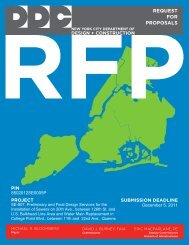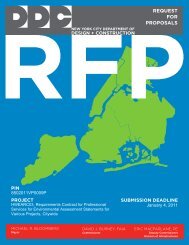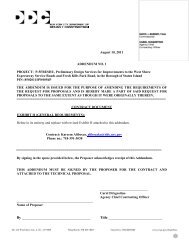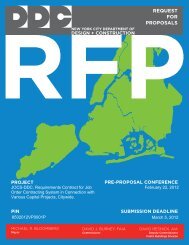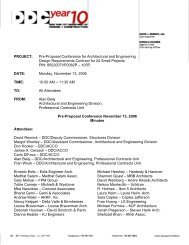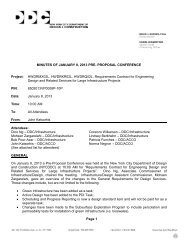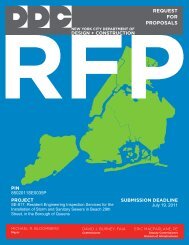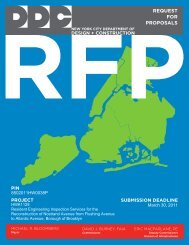requirements contracts for engineering design and related services ...
requirements contracts for engineering design and related services ...
requirements contracts for engineering design and related services ...
You also want an ePaper? Increase the reach of your titles
YUMPU automatically turns print PDFs into web optimized ePapers that Google loves.
2. MPT, <strong>for</strong> the purposes of this contract shall refer to, include <strong>and</strong> address all pedestrian traffic within <strong>and</strong> crossing the<br />
site, all modes of vehicular traffic within <strong>and</strong> crossing the site, <strong>and</strong> access <strong>and</strong> egress <strong>for</strong> all properties fronting <strong>and</strong>/or<br />
affected by the proposed construction work.<br />
3. At the appropriate stage in the development of the Composite Contract Documents <strong>and</strong>/or as accepted in the <strong>design</strong><br />
work schedule or as otherwise directed by the Commissioner, the Consultant shall initiate the MPT planning activity.<br />
4. The Consultant shall develop a "Specific MPT Plan", which shall be specific to the site <strong>and</strong> specific to the site<br />
properties. The plan shall provide, where appropriate, <strong>for</strong> construction work to be advanced concurrently in subsections of<br />
the project to allow <strong>for</strong> accelerated completion of the work.<br />
5. The Consultant shall examine various MPT strategies <strong>for</strong> portions <strong>and</strong>/or all of the project street(s) including but not<br />
limited to proposals <strong>for</strong> street closures, full or partial detour(s), one-way street conversions or other appropriate MPT<br />
staging techniques.<br />
6. The Consultant shall familiarize him/herself regarding the operation, activity <strong>and</strong> intensity of traffic within the project<br />
site on a block by block <strong>and</strong> zone of influence basis, <strong>and</strong> shall identify, analyze, study <strong>and</strong> address <strong>and</strong>/or mitigate issues<br />
including, but not limited to, the following: main line traffic volumes; intersecting street(s) traffic volumes; turning<br />
movements; vehicular classifications {cars, trucks, buses, railroad(s)}, curbside activity (loading <strong>and</strong> unloading); parking<br />
<strong>requirements</strong>; planned special events (parades, street fair(s), marathon); special traffic generators (hospitals, police<br />
stations, large parking garages or areas); public or private institutional properties; manufacturing/warehousing facilities,<br />
supermarkets, fire stations, government buildings, parks, schools, subway stations; intense traffic generators (all types of<br />
commercial, manufacturing, warehousing establishments); other current or planned construction projects within the zone of<br />
influence; <strong>and</strong> all sources of pedestrian activity.<br />
7. The Consultant shall develop the MPT plan generally in three stages - as follows:<br />
A. STAGE 1 - CONCEPTUAL MPT PLAN. In this stage the Consultant shall:<br />
a) Conceptualize the overall MPT strategy <strong>and</strong>, more specifically, conceptualize subdividing the project <strong>for</strong><br />
concurrent staging of the work where applicable, <strong>and</strong> the staging of each category of the proposed construction<br />
work (such as sewer lining, sewer reconstruction, catch basin/inlet installation <strong>and</strong> basin/inlet connections, water<br />
mains - 12, 20, 36, 48 inch, installation of hydrants, curb construction, sidewalk construction, roadway base<br />
construction, <strong>and</strong> laying roadway wearing course);<br />
b) Meet with <strong>and</strong> present his/her conceptual scheme to the Commissioner including presentation of the rationale<br />
<strong>for</strong> pursuing the selected MPT strategy based on the in<strong>for</strong>mation, analysis <strong>and</strong> issues identified above. The<br />
presentation shall include graphics, which shall be suitable <strong>and</strong> adequate to demonstrate/represent the conceptual<br />
scheme(s);<br />
c) Upon receipt of general concurrence from the Commissioner or direction to pursue additional alternative(s) the<br />
Consultant shall proceed with Stage II of the MPT development.<br />
B. STAGE II - PRELIMINARY MPT DEVELOPMENT. In this stage the Consultant shall:<br />
a) Respond to the questions <strong>and</strong> concerns raised during the Conceptual MPT planning strategy session <strong>and</strong><br />
develop the MPT proposals to a preliminary level of detail <strong>for</strong> each stage of construction work (such as but not<br />
limited to sewer lining, sewer reconstruction, catch basin/inlet installation <strong>and</strong> basin/inlet connections, water mains -<br />
12, 20, 36, 48 inch, installation of hydrants, curb construction, sidewalk construction, roadway base construction,<br />
<strong>and</strong> laying roadway wearing course);<br />
b) Develop <strong>and</strong> provide graphics <strong>and</strong> notes to specifically describe the proposed MPT plans <strong>for</strong> each category of<br />
construction work. For this presentation the Consultant may be permitted to use 8 1/2 by 11 or 8 1/2 by 14 inch<br />
sheet sizes, as an alternative to the st<strong>and</strong>ard contract drawing sheet size, with h<strong>and</strong> drawn sketches provided that<br />
the graphics are of a professional quality <strong>and</strong> acceptable to the City;<br />
NYC Department of Design <strong>and</strong> Construction<br />
Infrastructure, October 2012<br />
GR-67




